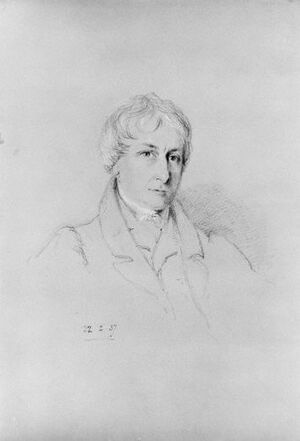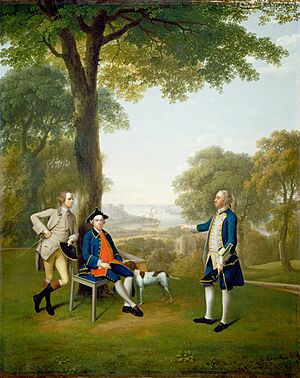Arthur Howe Holdsworth facts for kids
Arthur Howe Holdsworth (born 1780, died 1860) was an important English merchant and politician from Devon. His family lived at Mount Galpin in Townstal and Widdicombe in Stokenham.
The Holdsworth Family Story
The Holdsworth family originally came from Yorkshire. An ancestor, who was a vicar (a type of priest), moved to Devon in 1620. His son, also named Arthur, started a business. With help from another family, the Champernownes, he began a very profitable trade with Newfoundland. By 1672, he was the mayor of Dartmouth and a very powerful person in local business.
Over the next 200 years, the Holdsworth family became very important in Dartmouth's business and culture. They were leaders in trade with Newfoundland and Portugal, where they even owned land. Their business also reached places like the Baltic Sea, the West Indies, and America.
The family kept growing richer. In 1725, they were given control over "The Waters of the Dart" by the Duchy of Cornwall. This meant they could collect money (tolls) from all goods brought ashore between Salcombe and Torbay. This special right lasted until 1860 and made them very wealthy. The Holdsworths and their relatives held many important jobs in and around Dartmouth. They were mayors, governors of Dartmouth Castle, and even rectors (church leaders) in nearby towns. Their main family home was Widdicombe House, built in 1785 and made bigger in 1820. They also owned another house called Brookhill in Dartmouth.
Arthur Howe Holdsworth's Life and Work
Arthur Howe Holdsworth came from a family of successful merchants and traders in Devon. His father, also named Arthur Holdsworth, was a Member of Parliament and a well-known shipowner.
Arthur Howe Holdsworth was a very active businessman. He was involved in shipping and was also an inventor! He held many patents, mostly for new ideas about shipbuilding and boats. He owned shares in the Bristol and Exeter Railway and was a key person behind Devon's growing shipping businesses.
He lived at Widdicombe House and Mount Galpin in Dartmouth. These homes were near Kingsbridge, on land that had belonged to the Holdsworth family for many years. He was the last Governor of Dartmouth. In 1809, he was the Governor of Dartmouth Castle, a position his father had held before him.
Arthur Howe Holdsworth was elected as a Member of Parliament for Dartmouth in 1802. He held this position until December 1819. He then gave up his seat to Charles Milner Ricketts, who was a cousin of Lord Liverpool. He returned to Parliament for Dartmouth in 1829. However, he was defeated in 1832 by John Seale. This happened after the Reform Act changed how votes were counted in that area.
After this defeat, the Holdsworth family left Dartmouth. There was a lot of bad feeling between the Holdsworths and the Seale family. This was because the Seales had challenged the Holdsworth family's long-held power in the town. This rivalry was so strong that when Holdsworth's daughter, Catherine Henrietta Elizabeth Holdsworth, married civil engineer William Froude in 1839, they had to move the wedding. Instead of getting married in Dartmouth, where the Holdsworths had always gone to church, they held the ceremony at the Brixham parish church.
When Arthur Howe Holdsworth died in 1860, he left behind a very large fortune.
Arthur Howe Holdsworth's Family
In 1807, Arthur Howe Holdsworth married Catherine Henrietta Eastabrooke (1789-1878). Her parents were John Eastabrooke and Catherine Henrietta. Arthur's middle name, "Howe," was a tribute to a family friend, the British Admiral Richard Howe, 1st Earl Howe. Admiral Howe had also served as a Member of Parliament for Dartmouth from 1757 to 1782, at the same time as Arthur Howe Holdsworth's father.
The Holdsworth family later married into other important families from the West Country. These included the St. Aubyns of St. Michael's Mount, Cornwall, and the Bastard family of Devon. Members of the Bastard family, like Edmund Bastard, Edmund Pollexfen Bastard, and John Bastard, served in Parliament for Dartmouth alongside Arthur Howe Holdsworth.
Arthur Howe Holdsworth's oldest son, Arthur Bastard Eastabrook Holdsworth, lived at Widdicombe House after his father passed away. Arthur Bastard Eastabrook Holdsworth's first daughter, Alice Mary, married Edmund St. Aubyn in Dartmouth in 1869. His second daughter, Georgina, married Thomas Levett-Prinsep in 1868 in Stokenham, Devon. Thomas was the oldest son of Thomas Levett-Prinsep, a JP from Croxall Hall, Derbyshire. The St. Aubyns had two sons and four daughters, and the Levett-Prinseps had one son and one daughter.



